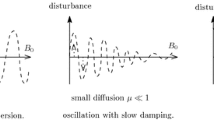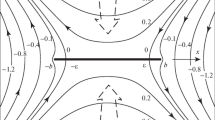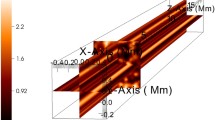Abstract
Magnetic islands are the regions enclosed by magnetic field lines and separated by reconnection points. In this paper, we study the long-time behavior of the solution for the linearized MHD system around the linearly stable, steady flowing plasma with sheared velocity and magnetic field. As a consequence, we prove that for a class of initial data, the magnetic islands appear at the final state.





Similar content being viewed by others
References
Bardos, C., Sulem, C., Sulem, P.L.: Long-time dynamics of a conductive fluid in the presence of a strong magnetic field. Trans. Am. Math. Soc. 305, 175–191, 1988
Bedrossian, J., Coti Zelati, M., Vicol, V.: Vortex axisymmetrization, inviscid damping, and vorticity depletion in the linearized 2D Euler equations. Ann. PDE 5, 192, 2019
Biskamp, D.: Magnetic reconnection via current sheets. Phys. Fluids 29, 1520–1531, 1986
Biskamp, D.: Magnetic Reconnection in Plasmas. Cambridge Monographs on Plasma Physics. Springer, Berlin (2005)
Cai, Y., Lei, Z.: Global well-posedness of the incompressible magnetohydrodynamics. Arch. Ration. Mech. Anal. 228, 969–993, 2018
Davidson, P.A.: An Introduction to Magnetohydrodynamics. Cambridge University Press, Cambridge (2001)
Grossmann, W., Tataronis, J.: The excitation of waves and resonances in high-beta plasmas. In: Proceedings of the 2nd Topical Conference on Pulsed High-Beta Plasmas, IPP-Report 1/127, Paper B-6, 1972
He, L., Xu, L., Yu, P.: On global dynamics of three dimensional magnetohydrodynamics: nonlinear stability of Alfvén waves. Ann. PDE 4, 105, 2018
Heyvaerts, J., Priest, E.R.: Coronal heating by phase-mixed shear Alfvén waves. Astron. Astrophys. 117, 200–234, 1983
Hirota, M., Tatsuno, T., Yoshida, Z.: Resonance between continuous spectra: secular behavior of Alfvén waves in a flowing plasma. Phys. Plas. 12, 012107, 2005
Lifschitz, A.: Magnetohydrodynamics and Spectral Theory. Kluwer Academic Publishers, Dordrecht (1989)
Liu, H., Masmoudi, N., Zhai, C., Zhao, W.: linear damping and depletion in flowing plasma with strong sheared magnetic fields. arXiv:2103.14614 (2021).
Ren, C., Chu, M.S., Callen, J.D.: Magnetic island deformation due to sheared flow and viscosity. Phys. Plasmas 6, 1203–1207, 1999
Ren, S., Wei, D., Zhang, Z.: Long time behavior of Alfvén waves in flowing plasma: the destruction of magnetic island. Preprint.
Ren, S., Zhao, W.: Linear damping of Alfvén waves by phase mixing. SIAM J. Math. Anal. 49, 2101–2137, 2017
Stern, M.E.: Joint instability of hydromagnetic fields which are separately stable. Phys. Fluids 6, 636–642, 1963
Tataronis, J., Grossmann, W.: On the spectrum of ideal MHD. In: Proceedings of the 2nd Topical Conference on Pulsed High-Beta Plasmas, IPP-Report 1/127, Paper B-5, 1972
Tataronis, J., Grossmann, W.: Decay of MHD wave by phase mixing I. The sheet-pinch in plane geometry. Z. Phys. 261, 203–216, 1973
Uberoi, C.: Alfvén waves in inhomogeneous magnetic fields. Phys. Fluids 2, 1673–1675, 1972
Waelbroeck, F.L.: Theory and observations of magnetic islands. Nucl. Fusion 49, 104025, 2009
Wei, D., Zhang, Z.: Global well-posedness of the MHD equations in a homogeneous magnetic field. Anal. PDE 10, 1361–1406, 2017
Wei, D., Zhang, Z., Zhao, W.: Linear inviscid damping for a class of monotone shear flow in Sobolev spaces. Commun. Pure Appl. Math. 71, 617–687, 2018
Wei, D., Zhang, Z., Zhao, W.: Linear inviscid damping and vorticity depletion for shear flows. Ann. PDE 5, 101, 2019
Wei, D., Zhang, Z., Zhao, W.: Linear inviscid damping and enhanced dissipation for the Kolmogorov flow. Adv. Math. 362, 106963, 2020
Wei, D., Zhang, Z., Zhu, H.: Linear inviscid damping for the \(\beta \)-Plane equation. Commun. Math. Phys. 375, 127–174, 2020
Zillinger, C.: Linear inviscid damping for monotone shear flows. Trans. Am. Math. Soc. 369, 8799–8855, 2017
Zohm, H.: Magnetohydrodynamic Stability of Tokamaks. Wiley, New York (2015)
Acknowledgements
We would like to thank the referee for the invaluable comments and suggestions, which have helped us improve the paper significantly. Z. Zhang is supported by NSF of China under Grant 12171010.
Author information
Authors and Affiliations
Corresponding author
Additional information
Communicated by N. Masmoudi.
Publisher's Note
Springer Nature remains neutral with regard to jurisdictional claims in published maps and institutional affiliations.
Appendix
Appendix
In this “Appendix”, let us complete the extension process for Case 2–9.
Case 2 \(W_+(1)= W_-(-1)>0> W_-(1)>W_+(-1)\). Let
for some \(\epsilon _0\in (0,1).\) We denote \( \Omega _{\epsilon _0}{\mathop {=}\limits ^{def}}D_0\cup D_{\epsilon _0}\cup B_{\epsilon _0}^{l}\cup B_{\epsilon _0}^{r}. \) We define
By Lemma 3.1, we can take a \(C^5\) extension of \(W_-\) to be \(\widetilde{W}_-\) for \(y\in [-1,\mathrm{{a}}_+]\) such that \(\widetilde{W}_-(\mathrm{{a}}_+)=W_+(-1)\) and \(\widetilde{W}'_-(y)<0\).
-
For \(c\in D_0\cup D_{\epsilon _0}\) and \(c_r\geqq 0\), we denote \(y_{c_+}\in [0,1]\) with \(y_{c_+}=(W_+)^{-1}(c_r)\) so that \(W_+(y_{c_+})-c_r=0\), and \(y_{c_-}\in [-1,0]\) with \(y_{c_-}=(W_-)^{-1}(c_r)\) so that \(W_-(y_{c_-})-c_r=0\).
-
For \(c\in D_0\cup D_{\epsilon _0}\) and \(c_r\leqq 0\), we denote \(y_{c_+}\in [0,\mathrm{{a}}_+]\) with \(y_{c_+}=(\widetilde{W}_-)^{-1}(c_r)\) so that \(\widetilde{W}_-(y_{c_+})-c_r=0\), and \(y_{c_-}\in [-1,0]\) with \(y_{c_-}=(W_+)^{-1}(c_r)\) so that \(W_+(y_{c_-})-c_r=0\).
-
For \(c\in B_{\epsilon _0}^l\), then \(c_r=W_+(-1)=\widetilde{W}_-(\mathrm{{a}}_+)\), and we denote \(y_{c_+}=\mathrm{{a}}_+\) and \(y_{c_-}=-1\).
-
For \(c\in B_{\epsilon _0}^r\), then \(c_r=W_+(1)=W_-(-1)\), and we denote \(y_{c_+}=1\) and \(y_{c_-}=-1\).
We show the relationship between \(y_{c_+}, y_{c_-}\) and \(c_r\) in Fig. 6. We also take a \(C^5\) extension of \(W_+\) to be \(\widetilde{W}_+\) for \(y\in [-1,\mathrm{{a}}_+]\) so that \(\widetilde{W}_+'(y)>0\).
Case 3 \(W_-(-1)> W_+(1)>0> W_-(1)>W_+(-1)\). Let
for some \(\epsilon _0\in (0,1).\) We denote \( \Omega _{\epsilon _0}{\mathop {=}\limits ^{def}}D_0\cup D_{\epsilon _0}\cup B_{\epsilon _0}^{l}\cup B_{\epsilon _0}^{r}. \) We define
By Lemma 3.1, we can take a \(C^5\) extension of \(W_-\) to be \(\widetilde{W}_-\) and \(W_+\) to be \(\widetilde{W}_+\) for \(y\in [-1,\mathrm{{a}}_+]\) such that \(\widetilde{W}_-(\mathrm{{a}}_+)=W_+(-1)\), \(\widetilde{W}'_-(y)<0\) and \(\widetilde{W}_+(\mathrm{{a}}_+)=W_-(-1)\), \(\widetilde{W}'_+(y)>0\).
-
For \(c\in D_0\cup D_{\epsilon _0}\) and \(c_r\geqq 0\), we denote \(y_{c_+}\in [0,\mathrm{{a}}_+]\) with \(y_{c_+}=(\widetilde{W}_+)^{-1}(c_r)\) so that \(\widetilde{W}_+(y_{c_+})-c_r=0\), and \(y_{c_-}\in [-1,0]\) with \(y_{c_-}=(W_-)^{-1}(c_r)\) so that \(W_-(y_{c_-})-c_r=0\).
-
For \(c\in D_0\cup D_{\epsilon _0}\) and \(c_r\leqq 0\), we denote \(y_{c_+}\in [0,\mathrm{{a}}_+]\) with \(y_{c_+}=(\widetilde{W}_-)^{-1}(c_r)\) so that \(\widetilde{W}_-(y_{c_+})-c_r=0\), and \(y_{c_-}\in [-1,0]\) with \(y_{c_-}=(W_+)^{-1}(c_r)\) so that \(W_+(y_{c_-})-c_r=0\).
-
For \(c\in B_{\epsilon _0}^l\), then \(c_r=W_+(-1)=\widetilde{W}_-(\mathrm{{a}}_+)\), and we denote \(y_{c_+}=\mathrm{{a}}_+\) and \(y_{c_-}=-1\).
-
For \(c\in B_{\epsilon _0}^r\), then \(c_r=W_-(-1)=\widetilde{W}_+(\mathrm{{a}}_+)\), and we denote \(y_{c_+}=\mathrm{{a}}_+\) and \(y_{c_-}=-1\).
We show the relationship between \(y_{c_+}, y_{c_-}\) and \(c_r\) in Fig. 7.
Case 4 \(W_+(1)> W_-(-1)>0> W_-(1)=W_+(-1)\). Let
for some \(\epsilon _0\in (0,1).\) We denote \( \Omega _{\epsilon _0}{\mathop {=}\limits ^{def}}D_0\cup D_{\epsilon _0}\cup B_{\epsilon _0}^{l}\cup B_{\epsilon _0}^{r}. \) We define
By Lemma 3.1, we can take a \(C^5\) extension of \(W_-\) to be \(\widetilde{W}_-\) for \(y\in [\mathrm{{a}}_-,1]\) such that \(\widetilde{W}_-(\mathrm{{a}}_-)=W_+(1)\) and \(\widetilde{W}'_-(y)<0\).
-
For \(c\in D_0\cup D_{\epsilon _0}\) and \(c_r\geqq 0\), we denote \(y_{c_+}\in [0,1]\) with \(y_{c_+}=(W_+)^{-1}(c_r)\) so that \(W_+(y_{c_+})-c_r=0\), and \(y_{c_-}\in [\mathrm{{a}}_-,0]\) with \(y_{c_-}=(\widetilde{W}_-)^{-1}(c_r)\) so that \(\widetilde{W}_-(y_{c_-})-c_r=0\).
-
For \(c\in D_0\cup D_{\epsilon _0}\) and \(c_r\leqq 0\), we denote \(y_{c_+}\in [0,1]\) with \(y_{c_+}=(W_-)^{-1}(c_r)\) so that \(W_-(y_{c_+})-c_r=0\), and \(y_{c_-}\in [-1,0]\) with \(y_{c_-}=(W_+)^{-1}(c_r)\) so that \(W_+(y_{c_-})-c_r=0\).
-
For \(c\in B_{\epsilon _0}^l\), then \(c_r=W_+(-1)=W_-(1)\), and we denote \(y_{c_+}=1\) and \(y_{c_-}=-1\).
-
For \(c\in B_{\epsilon _0}^r\), then \(c_r=W_+(1)=\widetilde{W}_-(\mathrm{{a}}_-)\), and we denote \(y_{c_+}=1\) and \(y_{c_-}=\mathrm{{a}}_-\).
We show the relationship between \(y_{c_+}, y_{c_-}\) and \(c_r\) in Fig. 8. We also take a \(C^5\) extension of \(W_+\) to be \(\widetilde{W}_+\) for \(y\in [\mathrm{{a}}_-,1]\), so that \(\widetilde{W}_+'(y)>0\).
Case 5 \(W_+(1)> W_-(-1)>0> W_+(-1)>W_-(1)\). Let
for some \(\epsilon _0\in (0,1).\) We denote \( \Omega _{\epsilon _0}{\mathop {=}\limits ^{def}}D_0\cup D_{\epsilon _0}\cup B_{\epsilon _0}^{l}\cup B_{\epsilon _0}^{r}. \) We define
By Lemma 3.1, we can take a \(C^5\) extension of \(W_-\) to be \(\widetilde{W}_-\) and \(W_+\) to be \(\widetilde{W}_+\) for \(y\in [\mathrm{{a}}_-,1]\) such that \(\widetilde{W}_-(\mathrm{{a}}_-)=W_+(1)\), \(\widetilde{W}'_-(y)<0\) and \(\widetilde{W}_+(\mathrm{{a}}_-)=W_-(1)\), \(\widetilde{W}'_+(y)>0\).
-
For \(c\in D_0\cup D_{\epsilon _0}\) and \(c_r\geqq 0\), we denote \(y_{c_+}\in [0,1]\) with \(y_{c_+}=(W_+)^{-1}(c_r)\) so that \(W_+(y_{c_+})-c_r=0\), and \(y_{c_-}\in [\mathrm{{a}}_-,0]\) with \(y_{c_-}=(\widetilde{W}_-)^{-1}(c_r)\) so that \(\widetilde{W}_-(y_{c_-})-c_r=0\).
-
For \(c\in D_0\cup D_{\epsilon _0}\) and \(c_r\leqq 0\), we denote \(y_{c_+}\in [0,1]\) with \(y_{c_+}=(W_-)^{-1}(c_r)\) so that \(W_-(y_{c_+})-c_r=0\), and \(y_{c_-}\in [\mathrm{{a}}_-,0]\) with \(y_{c_-}=(\widetilde{W}_+)^{-1}(c_r)\) so that \(\widetilde{W}_+(y_{c_-})-c_r=0\).
-
For \(c\in B_{\epsilon _0}^l\), then \(c_r=W_-(1)=\widetilde{W}_+(\mathrm{{a}}_-)\), and we denote \(y_{c_+}=1\) and \(y_{c_-}=\mathrm{{a}}_-\).
-
For \(c\in B_{\epsilon _0}^r\), then \(c_r=W_+(1)=\widetilde{W}_-(\mathrm{{a}}_-)\), and we denote \(y_{c_+}=1\) and \(y_{c_-}=\mathrm{{a}}_-\).
We show the relationship between \(y_{c_+}, y_{c_-}\) and \(c_r\) in Fig. 9.
Case 6 \(W_+(1)=W_-(-1)>0> W_-(1)=W_+(-1)\). We do not extend \(W_{\pm }\) due to \(Ran\, W_+=Ran\, W_-\). Let
for some \(\epsilon _0\in (0,1).\) We denote \( \Omega _{\epsilon _0}{\mathop {=}\limits ^{def}}D_0\cup D_{\epsilon _0}\cup B_{\epsilon _0}^l\cup B_{\epsilon _0}^r. \) We define
-
For \(c\in D_0\cup D_{\epsilon _0}\) and \(c_r\geqq 0\), we denote \(y_{c_+}\in [0,1]\) with \(y_{c_+}=(W_+)^{-1}(c_r)\) so that \(W_+(y_{c_+})-c_r=0\), and \(y_{c_-}\in [-1,0]\) with \(y_{c_-}=(W_-)^{-1}(c_r)\) so that \(W_-(y_{c_-})-c_r=0\).
-
For \(c\in D_0\cup D_{\epsilon _0}\) and \(c_r\leqq 0\), we denote \(y_{c_+}\in [0,1]\) with \(y_{c_+}=(W_-)^{-1}(c_r)\) so that \(W_-(y_{c_+})-c_r=0\), and \(y_{c_-}\in [-1,0]\) with \(y_{c_-}=(W_+)^{-1}(c_r)\) so that \(W_+(y_{c_-})-c_r=0\).
-
For \(c\in B_{\epsilon _0}^l\), then \(c_r=W_-(1)=W_+(-1)\), and we denote \(y_{c_+}=1\) and \(y_{c_-}=-1\).
-
For \(c\in B_{\epsilon _0}^r\), then \(c_r=W_+(1)=W_-(-1)\), and we denote \(y_{c_+}=1\) and \(y_{c_-}=-1\).
We show the relationship between \(y_{c_+}\), \(y_{c_-}\) and \(c_r\) in Fig. 10.
Case 7 \(W_+(1)= W_-(-1)>0> W_+(-1)>W_-(1)\). Let
for some \(\epsilon _0\in (0,1).\) We denote \( \Omega _{\epsilon _0}{\mathop {=}\limits ^{def}}D_0\cup D_{\epsilon _0}\cup B_{\epsilon _0}^{l}\cup B_{\epsilon _0}^{r}. \) We define
By Lemma 3.1, we can take a \(C^5\) extension of \(W_+\) to be \(\widetilde{W}_+\) for \(y\in [\mathrm{{a}}_-,1]\) such that \(\widetilde{W}_+(\mathrm{{a}}_-)=W_-(1)\), \(\widetilde{W}'_+(y)>0\).
-
For \(c\in D_0\cup D_{\epsilon _0}\) and \(c_r\geqq 0\), we denote \(y_{c_+}\in [0,1]\) with \(y_{c_+}=(W_+)^{-1}(c_r)\) so that \(W_+(y_{c_+})-c_r=0\), and \(y_{c_-}\in [-1,0]\) with \(y_{c_-}=(W_-)^{-1}(c_r)\) so that \(W_-(y_{c_-})-c_r=0\).
-
For \(c\in D_0\cup D_{\epsilon _0}\) and \(c_r\leqq 0\), we denote \(y_{c_+}\in [0,1]\) with \(y_{c_+}=(W_-)^{-1}(c_r)\) so that \(W_-(y_{c_+})-c_r=0\), and \(y_{c_-}\in [\mathrm{{a}}_-,0]\) with \(y_{c_-}=(\widetilde{W}_+)^{-1}(c_r)\) so that \(\widetilde{W}_+(y_{c_-})-c_r=0\).
-
For \(c\in B_{\epsilon _0}^l\), then \(c_r=W_-(1)=\widetilde{W}_+(\mathrm{{a}}_-)\), and we denote \(y_{c_+}=1\) and \(y_{c_-}=\mathrm{{a}}_-\).
-
For \(c\in B_{\epsilon _0}^r\), then \(c_r=W_+(1)=W_-(-1)\), and we denote \(y_{c_+}=1\) and \(y_{c_-}=-1\).
We show the relationship between \(y_{c_+}, y_{c_-}\) and \(c_r\) in Fig. 11
We also take a \(C^5\) extension of \(W_-\) to be \(\widetilde{W}_-\) for \(y\in [\mathrm{{a}}_-,1]\) so that \(\widetilde{W}_-'(y)<0\).
Case 8 \(W_-(-1)> W_+(1)>0> W_-(1)=W_+(-1)\). Let
for some \(\epsilon _0\in (0,1).\) We denote \( \Omega _{\epsilon _0}{\mathop {=}\limits ^{def}}D_0\cup D_{\epsilon _0}\cup B_{\epsilon _0}^{l}\cup B_{\epsilon _0}^{r}. \) We define
By Lemma 3.1, we can take a \(C^5\) extension of \(W_+\) to be \(\widetilde{W}_+\) for \(y\in [-1,\mathrm{{a}}_+]\) such that \(\widetilde{W}_+(\mathrm{{a}}_+)=W_-(-1)\), \(\widetilde{W}'_+(y)>0\).
-
For \(c\in D_0\cup D_{\epsilon _0}\) and \(c_r\geqq 0\), we denote \(y_{c_+}\in [0,\mathrm{{a}}_+]\) with \(y_{c_+}=(\widetilde{W}_+)^{-1}(c_r)\) so that \(\widetilde{W}_+(y_{c_+})-c_r=0\), and \(y_{c_-}\in [-1,0]\) with \(y_{c_-}=(W_-)^{-1}(c_r)\) so that \(W_-(y_{c_-})-c_r=0\).
-
For \(c\in D_0\cup D_{\epsilon _0}\) and \(c_r\leqq 0\), we denote \(y_{c_+}\in [0,1]\) with \(y_{c_+}=(W_-)^{-1}(c_r)\) so that \(W_-(y_{c_+})-c_r=0\), and \(y_{c_-}\in [-1,0]\) with \(y_{c_-}=(W_+)^{-1}(c_r)\) so that \(W_+(y_{c_-})-c_r=0\).
-
For \(c\in B_{\epsilon _0}^l\), then \(c_r=W_+(-1)=W_-(-1)\), and we denote \(y_{c_+}=1\) and \(y_{c_-}=-1\).
-
For \(c\in B_{\epsilon _0}^r\), then \(c_r=W_-(-1)=\widetilde{W}_+(\mathrm{{a}}_+)\), and we denote \(y_{c_+}=\mathrm{{a}}_+\) and \(y_{c_-}=-1\).
We show the relationship between \(y_{c_+}, y_{c_-}\) and \(c_r\) in Fig. 12. We also take a \(C^5\) extension of \(W_-\) to be \(\widetilde{W}_-\) for \(y\in [-1, \mathrm{{a}}_+]\) so that \(\widetilde{W}_-'(y)<0\).
Case 9 \(W_-(-1)> W_+(1)>0> W_+(-1)>W_-(1)\). Let
for some \(\epsilon _0\in (0,1).\) We denote \( \Omega _{\epsilon _0}{\mathop {=}\limits ^{def}}D_0\cup D_{\epsilon _0}\cup B_{\epsilon _0}^{l}\cup B_{\epsilon _0}^{r}. \) We define
By Lemma 3.1, we can take a \(C^5\) extension of \(W_+\) to be \(\widetilde{W}_+\) for \(y\in [\mathrm{{a}}_-,\mathrm{{a}}_+]\) such that \(\widetilde{W}_+(\mathrm{{a}}_-)=W_-(1)\), \(\widetilde{W}_+(\mathrm{{a}}_+)=W_-(-1)\) and \(\widetilde{W}'_+(y)>0\).
-
For \(c\in D_0\cup D_{\epsilon _0}\) and \(c_r\geqq 0\), we denote \(y_{c_+}\in [0,\mathrm{{a}}_+]\) with \(y_{c_+}=(\widetilde{W}_+)^{-1}(c_r)\) so that \(\widetilde{W}_+(y_{c_+})-c_r=0\), and \(y_{c_-}\in [-1,0]\) with \(y_{c_-}=(W_-)^{-1}(c_r)\) so that \(W_-(y_{c_-})-c_r=0\).
-
For \(c\in D_0\cup D_{\epsilon _0}\) and \(c_r\leqq 0\), we denote \(y_{c_+}\in [0,1]\) with \(y_{c_+}=(W_-)^{-1}(c_r)\) so that \(W_-(y_{c_+})-c_r=0\), and \(y_{c_-}\in [\mathrm{{a}}_-,0]\) with \(y_{c_-}=(\widetilde{W}_+)^{-1}(c_r)\) so that \(\widetilde{W}_+(y_{c_-})-c_r=0\).
-
For \(c\in B_{\epsilon _0}^l\), then \(c_r=W_-(1)=\widetilde{W}_+(a_-)\), and we denote \(y_{c_+}=1\) and \(y_{c_-}=\mathrm{{a}}_-\).
-
For \(c\in B_{\epsilon _0}^r\), then \(c_r=W_-(-1)=\widetilde{W}_+(\mathrm{{a}}_+)\), and we denote \(y_{c_+}=\mathrm{{a}}_+\) and \(y_{c_-}=-1\).
We show the relationship between \(y_{c_+}, y_{c_-}\) and \(c_r\) in Fig. 13.
We also take a \(C^5\) extension of \(W_-\) to be \(\widetilde{W}_-\) for \(y\in [\mathrm{{a}_-}, \mathrm{{a}}_+]\) so that \(\widetilde{W}_-'(y)<0\).
In the last step of Case 2, 4, 7, 8, 9, we only restrict the regularity and monotonicity of the extension.
Rights and permissions
About this article
Cite this article
Zhai, C., Zhang, Z. & Zhao, W. Long-Time Behavior of Alfvén Waves in a Flowing Plasma: Generation of the Magnetic Island. Arch Rational Mech Anal 242, 1317–1394 (2021). https://doi.org/10.1007/s00205-021-01706-8
Received:
Accepted:
Published:
Issue Date:
DOI: https://doi.org/10.1007/s00205-021-01706-8












